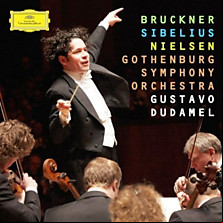BBC Review 1bj6o
Dudamel’s ‘souvenir’ from his GSO tenure is a rewarding triple-disc set.
Andrew Mellor 2011
It’s hard to think of two composers who demand such different approaches from conductors as Nielsen and Bruckner. The smooth, warm transparency that gives the latter’s huge rolling symphonies their spiritual weight would render Nielsen’s more angular, fissile late symphonies as flat as a pancake. To get either right a maestro needs to deploy an acute stylistic nous, which is presumably why both composers trip so many of them up.
Gustavo Dudamel doesn’t really trip up anywhere on this three-disc ‘souvenir’ from his tenure as Music Director of the Gothenburg Symphony Orchestra, but nor is his Bruckner absolutely ideal. In a sense it’s too nimble: the Ninth Symphony is a Rolls Royce if ever there was one, but Dudamel’s tends towards the Mini Cooper. Changes in colour and speed are sudden, urgent and purposeful. Despite some impeccable playing, you’re left without much feeling of mystery or transparency.
But his Nielsen is wholly different. Though in a sense, it isn’t: that turn-on-a-sixpence agility pays dividends when Nielsen purposefully flips the music of his Fourth and Fifth Symphonies from anger to rhapsody. Dudamel can handle the sudden change, but he’s also right there with each individual mood – as provocative as Blomstedt and as ionate as Vänskä.
It’s Dudamel’s adherence to the ‘golden rule’ of Nielsen interpretation – to never play it safe – that helps him most. The orchestral sections fight against each other with wickedly exciting three-dimensional force, yet still almost every bar is structurally sound. Yes, there’s the odd problem: the Fifth lacks tension at the apex of its ‘Part One’ crescendo and the Fourth suffers from a strange unevenness. But in music that’s so rarely recorded well, these are live performances to reach for when you need to remind yourself just how brilliantly impolite Nielsen really is.
Finally comes the surprise package of the set, Sibelius’ Second Symphony in a performance of such strength and freshness that it can send the listener running for Barbirolli’s delicious Royal Philharmonic Orchestra recording for comparison. Just when you thought Dudamel might go all soppy in Sibelius’ most carefree symphony, he goes and does the opposite. A craggy, determined performance emerges which at times has the music sounding like Sibelius’ Fourth.
In DG’s forward sound picture, you hear how hard each and every section of the Gothenburg Orchestra is working – and how well they’re playing. So much space and thought; so many surprising switches in mood and footing; so much to discover in music we thought we knew. If only DG had kept the audience reaction for posterity – as if this writer had been in Gothenburg, he’d have been shouting for more.



